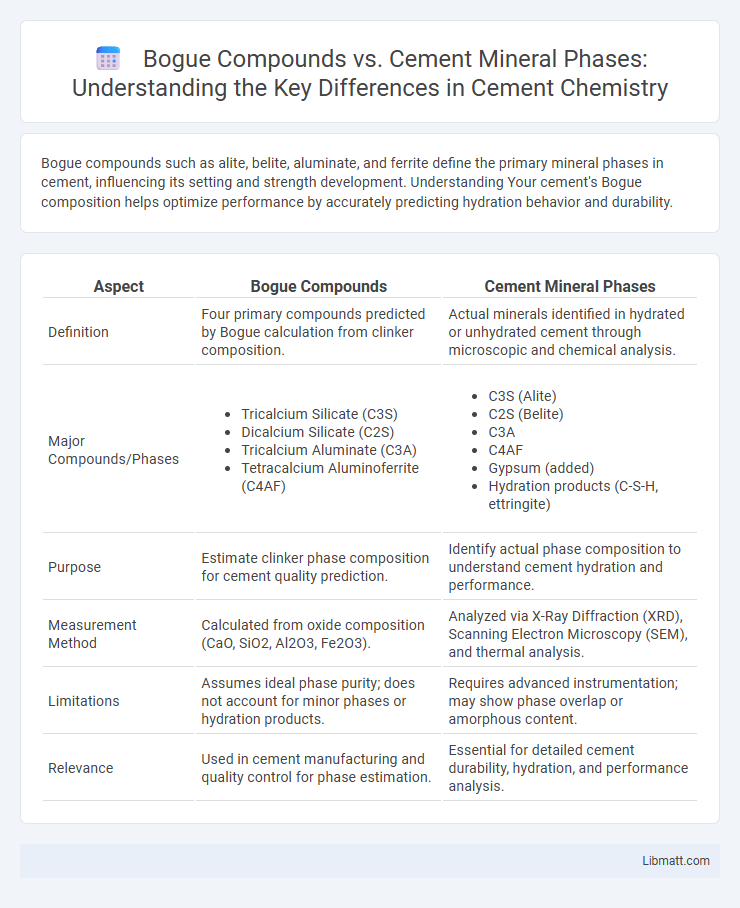Bogue compounds such as alite, belite, aluminate, and ferrite define the primary mineral phases in cement, influencing its setting and strength development. Understanding Your cement's Bogue composition helps optimize performance by accurately predicting hydration behavior and durability.
Table of Comparison
| Aspect | Bogue Compounds | Cement Mineral Phases |
|---|---|---|
| Definition | Four primary compounds predicted by Bogue calculation from clinker composition. | Actual minerals identified in hydrated or unhydrated cement through microscopic and chemical analysis. |
| Major Compounds/Phases |
|
|
| Purpose | Estimate clinker phase composition for cement quality prediction. | Identify actual phase composition to understand cement hydration and performance. |
| Measurement Method | Calculated from oxide composition (CaO, SiO2, Al2O3, Fe2O3). | Analyzed via X-Ray Diffraction (XRD), Scanning Electron Microscopy (SEM), and thermal analysis. |
| Limitations | Assumes ideal phase purity; does not account for minor phases or hydration products. | Requires advanced instrumentation; may show phase overlap or amorphous content. |
| Relevance | Used in cement manufacturing and quality control for phase estimation. | Essential for detailed cement durability, hydration, and performance analysis. |
Introduction to Bogue Compounds and Cement Mineral Phases
Bogue compounds are the primary mineral components formed during the clinkering process in cement production, including alite (C3S), belite (C2S), aluminate (C3A), and ferrite (C4AF). These compounds control the hydration reactions, strength development, and setting times of cement, making them essential for understanding cement performance. Your knowledge of the distinct roles of Bogue compounds within cement mineral phases can enhance the optimization of cement formulations for specific construction applications.
Historical Development of Bogue Compounds in Cement Chemistry
Bogue compounds, essential in defining cement mineral phases, were first identified by Robert Bogue in the early 20th century through X-ray diffraction studies. His pioneering work quantified key clinker phases--alite (C3S), belite (C2S), aluminate (C3A), and ferrite (C4AF)--which remain critical in understanding cement hydration and performance. Understanding these mineral phases allows you to optimize cement formulation for improved strength and durability in construction applications.
Key Cement Mineral Phases: Overview and Significance
Key cement mineral phases include alite (C3S), belite (C2S), aluminate (C3A), and ferrite (C4AF), each contributing uniquely to cement hydration and strength development. Alite drives early strength gain while belite ensures long-term durability, with aluminate and ferrite phases influencing setting time and chemical resistance. Understanding these mineral phases helps optimize your concrete mix for performance and sustainability.
Chemical Composition of Bogue Compounds vs Cement Minerals
Bogue compounds, including alite (C3S), belite (C2S), aluminate (C3A), and ferrite (C4AF), primarily consist of calcium silicates, aluminates, and ferrites with distinct stoichiometric ratios such as 3CaO*SiO2 for alite. Cement mineral phases reflect these compounds but exhibit variations due to hydration and the presence of impurities like gypsum and minor oxides, altering their chemical composition compared to the ideal Bogue phases. The chemical composition differences influence the hydration kinetics, mechanical strength, and durability of the resulting cementitious material.
Formation Processes: Bogue Compounds and Mineral Phases
Bogue compounds form through the rapid cooling and crystallization of clinker phases during cement manufacturing, primarily consisting of tricalcium silicate (C3S), dicalcium silicate (C2S), tricalcium aluminate (C3A), and tetracalcium aluminoferrite (C4AF). These phases arise from the high-temperature reactions between limestone and clay minerals in the kiln, producing distinct crystalline structures essential for cement hydration behavior. Mineral phases in cement, including quartz, calcite, and gypsum, typically result from raw materials or additives incorporated during grinding, influencing setting time and durability.
Role in Cement Hydration and Strength Development
Bogue compounds, consisting primarily of alite (C3S), belite (C2S), aluminate (C3A), and ferrite (C4AF), are critical in determining the hydration and strength properties of cement. Alite contributes to early strength development through rapid hydration, while belite hydrates more slowly, enhancing long-term strength. The aluminate phase reacts quickly with water and gypsum, influencing setting time and early strength, whereas the ferrite phase affects color and contributes modestly to overall strength.
Analytical Techniques for Identifying Cement Phases
X-ray diffraction (XRD) remains the primary analytical technique for identifying cement mineral phases, distinguishing between Bogue compounds such as alite, belite, aluminate, and ferrite based on their unique crystallographic patterns. Scanning electron microscopy (SEM) combined with energy-dispersive X-ray spectroscopy (EDS) offers microstructural and compositional insights, enabling precise phase identification and spatial distribution analysis. Fourier-transform infrared spectroscopy (FTIR) and Raman spectroscopy provide complementary molecular vibrational data, enhancing the differentiation of hydration products and complex Bogue phase transformations.
Differences in Physical and Mechanical Properties
Bogue compounds, primarily alite (C3S) and belite (C2S), exhibit higher early strength development and faster hydration rates compared to cement mineral phases such as aluminate (C3A) and ferrite (C4AF), which contribute to setting time and color. Alite provides superior mechanical properties like compressive strength, while belite influences long-term durability with slower strength gain. The physical differences in crystal structure affect water absorption and porosity, impacting the overall performance of cementitious materials in construction.
Impact on Cement Performance and Durability
Bogue compounds, primarily alite (C3S), belite (C2S), aluminate (C3A), and ferrite (C4AF), critically influence cement hydration kinetics and strength development, with alite providing rapid early strength and belite contributing to long-term durability. The mineralogical composition and proportions of these phases determine the resistance of cement to chemical attack, sulfate exposure, and alkali-silica reaction, directly affecting durability performance. Optimizing Bogue compound ratios enhances cement's mechanical properties and longevity, ensuring better performance in aggressive environmental conditions.
Conclusion: Comparing Bogue Compounds and Cement Mineral Phases
Bogue compounds, primarily alite, belite, aluminate, and ferrite, represent the theoretical mineral composition of Portland cement, derived from the clinker chemistry. Cement mineral phases, on the other hand, include both these compounds and other hydration products influencing the cement's physical and chemical properties. Understanding the balance between Bogue compounds and the actual mineral phases in your cement is essential for predicting performance characteristics such as strength development and durability.
Bogue Compounds vs Cement Mineral Phases Infographic

 libmatt.com
libmatt.com